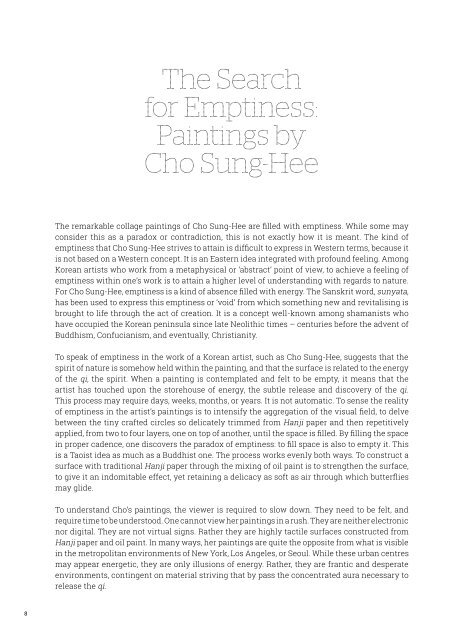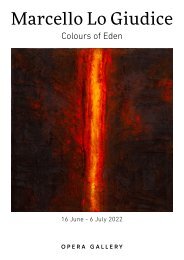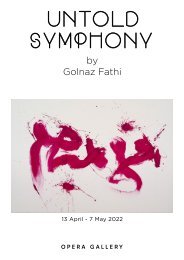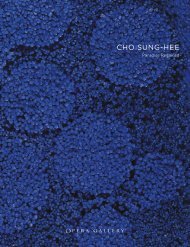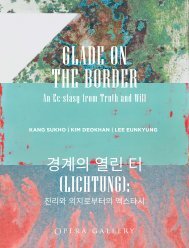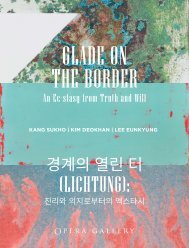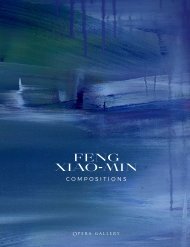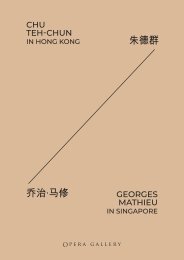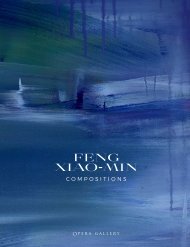Cho Sung-Hee: Splendid Stars
Cho Sung-Hee: Splendid Stars Solo exhibition in London, March 2018
Cho Sung-Hee: Splendid Stars
Solo exhibition in London, March 2018
Create successful ePaper yourself
Turn your PDF publications into a flip-book with our unique Google optimized e-Paper software.
The Search<br />
for Emptiness:<br />
Paintings by<br />
<strong>Cho</strong> <strong>Sung</strong>-<strong>Hee</strong><br />
The remarkable collage paintings of <strong>Cho</strong> <strong>Sung</strong>-<strong>Hee</strong> are filled with emptiness. While some may<br />
consider this as a paradox or contradiction, this is not exactly how it is meant. The kind of<br />
emptiness that <strong>Cho</strong> <strong>Sung</strong>-<strong>Hee</strong> strives to attain is difficult to express in Western terms, because it<br />
is not based on a Western concept. t is an Eastern idea integrated with profound feeling. Among<br />
Korean artists who work from a metaphysical or ‘abstract’ point of view, to achieve a feeling of<br />
emptiness within one’s work is to attain a higher level of understanding with regards to nature.<br />
For <strong>Cho</strong> <strong>Sung</strong>-<strong>Hee</strong>, emptiness is a kind of absence filled with energy. The Sanskrit word, sunyata,<br />
has been used to express this emptiness or ‘void’ from which something new and revitalising is<br />
brought to life through the act of creation. t is a concept well-known among shamanists who<br />
have occupied the Korean peninsula since late eolithic times – centuries before the advent of<br />
uddhism, Confucianism, and eventually, Christianity.<br />
To speak of emptiness in the work of a Korean artist, such as <strong>Cho</strong> <strong>Sung</strong>-<strong>Hee</strong>, suggests that the<br />
spirit of nature is somehow held within the painting, and that the surface is related to the energy<br />
of the qi, the spirit. When a painting is contemplated and felt to be empty, it means that the<br />
artist has touched upon the storehouse of energy, the subtle release and discovery of the qi.<br />
This process may require days, weeks, months, or years. t is not automatic. To sense the reality<br />
of emptiness in the artist’s paintings is to intensify the aggregation of the visual field, to delve<br />
between the tiny crafted circles so delicately trimmed from Hanji paper and then repetitively<br />
applied, from two to four layers, one on top of another, until the space is filled. y filling the space<br />
in proper cadence, one discovers the paradox of emptiness to fill space is also to empty it. This<br />
is a Taoist idea as much as a uddhist one. The process works evenly both ways. To construct a<br />
surface with traditional Hanji paper through the mixing of oil paint is to strengthen the surface,<br />
to give it an indomitable effect, yet retaining a delicacy as soft as air through which butterflies<br />
may glide.<br />
For <strong>Cho</strong> <strong>Sung</strong>-<strong>Hee</strong>,<br />
emptiness is a kind<br />
of absence filled<br />
with energy.<br />
Often, <strong>Cho</strong>’s paintings appear as a monochrome surface,<br />
a single uniform colour, such as bright red or subtle grey<br />
or pure white. ure white is also a colour from the East<br />
Asian point of view. n fact, white is the processed colour<br />
of Hanji paper, originally made from the ground leaves of<br />
mulberry trees. n constructing the surface of her paintings, the artist uses a collage method in<br />
which each circle is hand-cut or gently torn, then layered with oil pigments and placed one atop<br />
another. Each tiny circle is the sie of a thumbprint. Occasionally, <strong>Cho</strong> will mix red and green<br />
circles, clashing them together. n another example, the surface has a mixture of three colours –<br />
red, green and blue. Here, one may see the circular shapes are slightly larger. n looking at such<br />
a painting, the references to nature are abundant sky and water, grass and trees, vivid sunsets<br />
and the blood that circulates within the human body. Another deeply textured painting by <strong>Cho</strong><br />
involves the integration of red and yellow pigments on tiny fragments of thickly layered Hanji,<br />
in which each element is saturated with intense colour.<br />
n speaking with the artist, it seems that the circles that appear in her paintings were initially<br />
realised in a papier-mch rectilinear shape from , set on a vertical axis, in which larger cut<br />
circle shapes appeared at the top. The artist believes these circular shapes – which symbolically<br />
relate to the passing of her father – where the beginning of the circle theme in her most recent<br />
work. However, in studying the work of other contemporary Korean artists, it would appear that<br />
the circle may also be a cultural signifier that refers to a sense of wholeness within the social<br />
structure that functions symbolically as an atavistic sign of the individual soul in relation to the<br />
larger Korean community, which would include ancestor worship from the past.<br />
One of the most fascinating aspects in <strong>Cho</strong> <strong>Sung</strong>-<strong>Hee</strong>’s work is how her collage paintings<br />
attend to what is both visible and invisible – what is present and what is past. This continuity<br />
of history reaches beyond the singular soul into the realm of a historical nexus of individuals,<br />
each possessing souls that are somehow unified together within the larger Korean family. <strong>Cho</strong><br />
<strong>Sung</strong>-<strong>Hee</strong>’s paintings are a search for emptiness because emptiness is the basis of nature and<br />
the source of energy as transmitted through the qi. What we see in her paintings is the visual<br />
splendour of her imagination at work, and what we feel through her work is the hidden past,<br />
the tradition of Korean culture that is safeguarded through language and the desire to express<br />
inherent feelings that ultimately belong to art. Finally, it is through the art of <strong>Cho</strong> <strong>Sung</strong>-<strong>Hee</strong> that<br />
we discover the pulse of Korean tradition and the sentimental traits by which Korean people<br />
identify themselves. This is the important value that resides within the visible, yet beneath the<br />
surface of these deeply felt paintings.<br />
To understand <strong>Cho</strong>’s paintings, the viewer is required to slow down. They need to be felt, and<br />
require time to be understood. One cannot view her paintings in a rush. They are neither electronic<br />
nor digital. They are not virtual signs. ather they are highly tactile surfaces constructed from<br />
Hanji paper and oil paint. n many ways, her paintings are quite the opposite from what is visible<br />
in the metropolitan environments of ew ork, Los Angeles, or Seoul. While these urban centres<br />
may appear energetic, they are only illusions of energy. ather, they are frantic and desperate<br />
environments, contingent on material striving that by pass the concentrated aura necessary to<br />
release the qi.<br />
Robert C. Morgan, h.D.<br />
8 9


